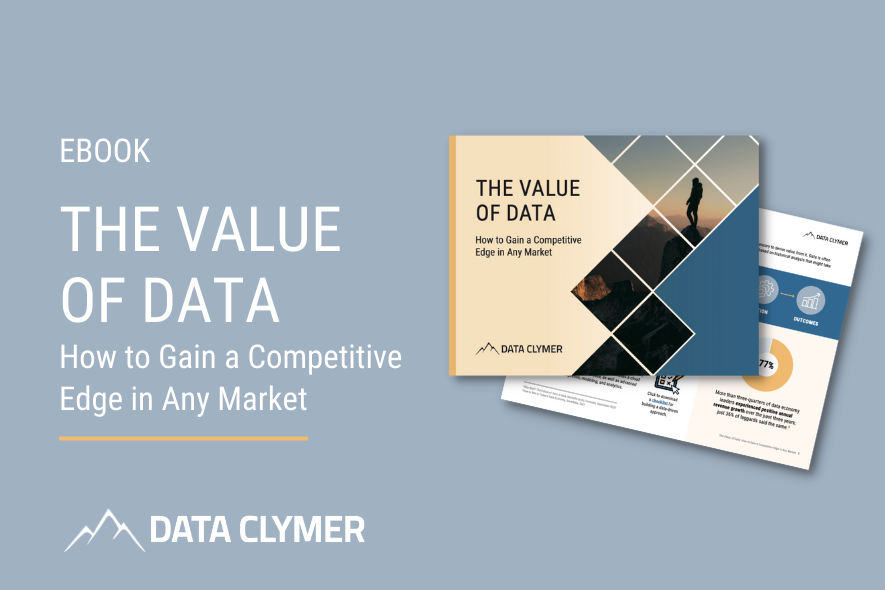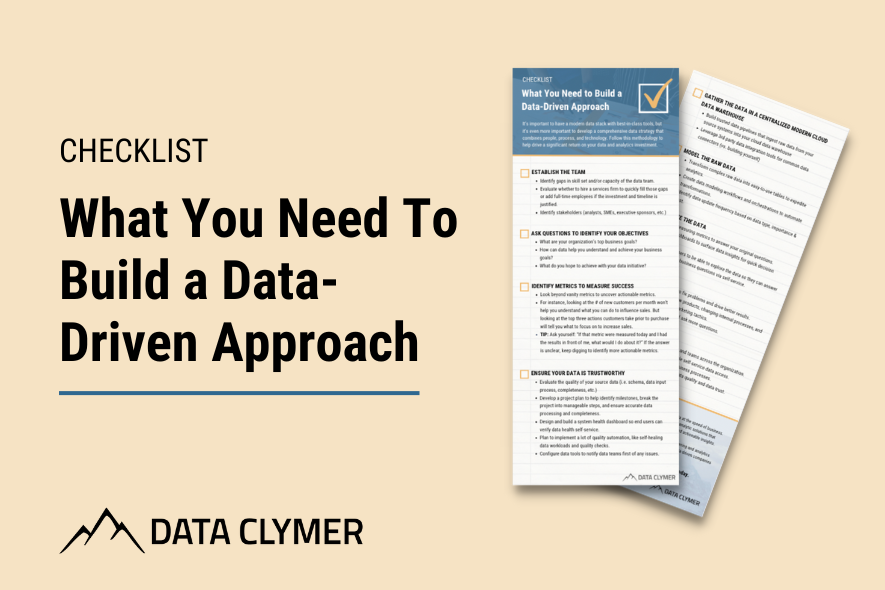Here’s a rundown of what data leaders and their teams should expect in 2023—and recommendations on how to successfully navigate the terrain.
It’s that time of year when 2023 trends and predictions are everywhere. It’s no different for the data industry. As businesses look for new, more efficient ways to manage exponentially increasing volumes of data, many experts expect to see continued growth in cloud data warehouses, reverse ETL, data apps, and data observability tools.
But where should data leaders focus their efforts? It can be challenging to know where to invest limited resources, especially in an uncertain economy. We talked to our leadership and data team to get their thoughts on 2023 data trends, challenges, and recommendations.
We hope their insights help you unlock the value of data in the year ahead. Subscribe to receive more insights from our data experts, straight to your inbox.
Contents
What data trends will take center stage in 2023?
What challenges will data leaders and data teams face?
What are your recommendations for data leaders?
Question 1
What data trends will take center stage in 2023?
We've seen rapid innovation in data warehousing and analytics over the last few years—and that's only going to continue. From new tools and apps to shifts in culture and mindset, one thing is certain: more change is ahead.
The Rise of the Data Warehouse
"The data warehouse is moving more and more into an operational role for the company and becoming more critical to run the business. Traditionally, data warehouses were a place for doing internal analytics, dashboarding, and reports. Because the data warehouse is now the best place to get a clean 360-degree view of the customer, more and more companies are pushing this data back into their operational applications to create a better customer experience."
— Aron Clymer, CEO and Founder





Data Observability
"Organizations really want to get better visibility into data issues—not only for the data platform, but also to support their product teams with whatever product data they’re working with. A lot of organizations are finding success in using the data warehouse as a hub of information to help understand where they may have data quality issues, then putting data observability tools like Monte Carlo and Kensu in place to help guide action to address data quality."
— Sharon McKinney, Engagement Manager
Do More with Less
“'Do more with less’ will be a macro trend. As we’ve watched the last year unfold, a lot of businesses made growth-oriented decisions based on having money in the bank, but they may not have had a data-driven business plan behind it. Companies will increasingly see the need to get more connected to their systems and sources so they can get more insights and take action.”
— Steve Shauck, Chief Sales Officer







Focus on Efficiencies
“We’ll see a refocusing of the data team to focus on efficiencies within the company. Data will be more important than ever as companies look to drive cost and labor efficiencies, improve the bottom line, and find ways to get more value from every department. Data will also be used to determine the ROI of specific projects and drive future decisions.”
— Jason Moffett, Director of Delivery
Related Resource: How to Use Data to Thrive in an Uncertain Economy
Simplification and Consolidation
“Most companies are seeing longer sales cycles and more required sign-offs on budgeting. Even for investments where the value is there, people are taking their time with decisions. Simplification and consolidation will be key.”
— Brian Albers, COO/CFO







There's an App for That
“As a society, we’ve moved away from monolithic tools and toward shared marketplaces. We’ll see the same evolution with the concept of BI tools and data apps. Rather than adding yet another tool to your stack, you’ll be able to log into a native app marketplace like the one Snowflake is building, find the apps you need, and download them into your environment. This is the future of BI and data analytics.”
— Jake Stewart, Cloud Data Engineer
Related: Data Apps to Power Your Business
Architectural Evolution
"We’ll continue to see a lot of growth with the lakehouse architecture Databricks has developed. Having all of your data in one location helps organizations dramatically speed up the time to reporting and analysis. Databricks has traditionally been thought of as a more advanced solution, but partners like Matillion, Sigma, and Fivetran are making it easier for organizations that aren’t as mature in their data journeys to access the future of analytics and warehousing."
— Pat Ross, Solution Architect








Growth in Analytics Engineering
“dbt is huge and it’s only growing because of how functional and effective it is. I think we’ll see more companies start using it and doing more with it. There was a time you’d ingest everything and wouldn’t be able to do all the modeling we’re doing now."
— Rob Seaberg, Cloud Data Engineer Team Lead
Question 2
What challenges will data leaders and their teams face?
It's no surprise that the economic environment is creating turbulence for a lot of businesses. Like most executives, data leaders will be looking for ways to save costs and prove value in 2023. Planning, resourcing, tool selection, and ROI top our list of challenges ahead.
Agile Planning
“Leaders will need to be prepared to shift their focus and priorities quickly. Whereas they might normally be doing roadmapping, planning will get more difficult. It may become easier to find skilled workers, but if they don't have budget to hire, they'll still be struggling with resources.”
— Aron Clymer, CEO and Founder









Resourcing
“As self-servicing becomes more common, the structure and required skill sets for your data team change. Finding the right resources can be extra challenging because job roles and functions are a lot less defined. Data-as-a service requires a more nuanced understanding of business processes, so you need a blending of business and technical skills."
— Sharon McKinney, Engagement Manager
Proving ROI
“Make sure you can prove the value before starting the project. What is the intended outcome? What are the available toolsets and the best way to get there? Discussing outcomes with the project stakeholders has never been more important. Results and outcomes need to come first.”
— Jason Moffett, Director of Delivery








Competitive Pressure
“The most valuable, successful companies in the world tend to be the ones that are best not just at collecting data, but also turning that data into valuable insights. Data leaders will see increased pressure to drive more value from their data and get everyone to hop on board.”
— Pat Ross, Solution Architect
Cultural Transformation
"Cultural transformation will be the #1 data challenge in 2023. It’s a big step to move away from people having their own spreadsheets and toward a culture that puts faith and trust in data analysts and engineers. The majority of industries are still very early in their data journey."
— Jake Stewart, Cloud Data Engineer








Tool Selection
"There is so much change in the data space, it can be overwhelming. How do you know which tools are worth taking the time to look into and formulate an opinion? Keeping up with new technologies amidst day-to-day responsibilities will always be a challenge for most data professionals.”
— Rob Seaberg, Cloud Data Engineer Team Lead
Question 3
What are your recommendations for data professionals in 2023?
With every challenge comes opportunity. Amidst bumpy market conditions, data leaders and their teams can seize opportunities to use data to improve operational efficiencies, prove the value of data-driven decision-making, and gain a competitive advantage.




Improve Communication and Collaboration Skills
“Get comfortable with communication across your company. You need to not only think about the data you’re taking in from your sources of truth, but also how you’re sharing it back out to your other systems and stakeholders. Give people a framework to work with, build out flexible visualizations where they can get at the data, and make it easy for them to interact with and use for their own decision-making purposes.”
— Sharon McKinney
Focus on Data Democratization
“Identify all of the proponents of the system and the people who are excited. Train them up and have them train the company. Think about ways to action your data and get it into the hands of everybody. That’s what’s really going to make a difference.”
— Aron Clymer, CEO and Founder








Use Data to Solve Problems
“Understand your business challenges and leverage experts to solve them using data. You can’t make decisions solely based on your gut forever. You need to dive in, find the information, and make it accessible and understandable to key decision-makers.”
— Brian Albers, CFO/COO
Start Small, Go Fast
“You can’t start big anymore because budgets are getting tight. Go find a use case that will have a disproportionate gain for the business. Lean into that, prove it out, and share the proof to your other business partners to help the enterprise go faster behind the data initiative.”
— Steve Shauck, Chief Sales Officer







Embrace a design pattern and structure
"Bring in a more structured approach to all the work you do. So many companies have such a new and small data team, there isn’t a lot of overall consistency. Leverage software engineering processes to create structure throughout your team's overall technical development process. Think about how to decide upon, promote, improve new changes so your reporting is stable and accurate."
— Rob Seaberg, Cloud Data Engineer
Modernize Your Tech Stack
“So many organizations are still doing work the old-fashioned way, out of Excel or using on-premise data servers. The new cloud data warehousing solutions have become so cost-effective and the various integration tools make them very easy to use. For mid-market firms early on in their data journeys, it’s low-hanging fruit. The first investment toward modernization is where you can have the most impact.”
— Pat Ross, Solution Architect








Tell the Story of ROI
“Analyze where you currently stand and make sure everything is running optimally. Look less at new features and functionality and more at data integrity. And make sure you’re getting good at telling the story of ROI. Spend time touting the benefits of the work you’ve already done.”
— Jason Moffett, Director of Delivery
Go Back to the Basics
"If you have a system that isn’t as trustworthy as it should be, now is the time to go back and make sure existing data is trusted and robust. Fortify the foundation of what you’re doing. A downward economic situation is the ideal time to get back to basics. Shore up your data warehouse and ensure the basics are in place."
— Aron Clymer, CEO and Founder









Trust the Experts
"Make sure you have the people and structure in place before projects begin. It’s the classic advice of, ‘Right people, right tools for the job.’ And if you don’t have the people you need, Data Clymer has so many skilled engineers with strong analytics backgrounds. We can give insight into which areas to dive into and when."
— Jake Stewart, Cloud Data Engineer
Conclusion
Although 2023 may be a bumpy road for some organizations, data-driven businesses will continue to find ways to gain a competitive advantage amidst economic uncertainty. If you need help navigating 2023 data trends and unlocking the value of data, Data Clymer is here as an extension of your team. Subscribe to receive more insights and recommendations from our data engineers and leadership team.
Want to fast-track your data initiatives? Contact us to find out how we can help you quickly tap into actionable insights that improve your bottom line.
Here’s to data-driven success in the year to come!










